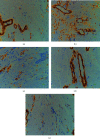Immunohistochemical Analysis of Postburn Scars following Treatment Using Dermal Substitutes
- PMID: 35251908
- PMCID: PMC8896958
- DOI: 10.1155/2022/3686863
Immunohistochemical Analysis of Postburn Scars following Treatment Using Dermal Substitutes
Abstract
Background: Post-burn hypertrophic scars commonly occur after burns. Studies that compare dermal substitutes with other treatment methods are insufficient. The purpose was to analyze the histopathological differences in hypertrophic burn scars after Matriderm®+split-thickness skin graft (STSG) and compare with AlloDerm®+STSG, STSG, full-thickness skin graft (FTSG), and normal skin.
Methods: Samples of unburned, normal skin and deep 2nd or 3rd degree burns were obtained from patients who experienced a burn injury in the past to at least 6 months before biopsy, which was performed between 2011 and 2012. All subjects received >6 months of treatment before the biopsy. Intervention groups were normal (63), STSG (28), FTSG (6), Matriderm® (11), and AlloDerm® (18). Immunohistochemical analyses of elastin, collagen I, collagen III, cluster of differentiation 31 (CD31), smooth muscle actin (α-SMA), and laminin from scar and control tissues were performed and compared.
Results: α-SMA vascular quantity and vessel width, stromal CD31, and basement membrane laminin expression were not significantly different between normal and intervention groups. Matriderm® group showed no significant difference in elastin, collagen III, stromal CD31 and α-SMA, CD31 vessel width, stromal α-SMA, vessel quantity and width, and laminin length compared to the normal group, meaning they were not significantly different from the normal skin traits.
Conclusion: Dermal substitutes may be an optimal alternative to address the cosmetic and functional limitations posed by other treatment methods.
Copyright © 2022 Mi Young Lee et al.
Conflict of interest statement
None declared.
Figures








Similar articles
-
A Histological and Clinical Study of MatriDerm® Use in Burn Reconstruction.J Burn Care Res. 2023 Sep 7;44(5):1100-1109. doi: 10.1093/jbcr/irad024. J Burn Care Res. 2023. PMID: 36945134 Free PMC article.
-
Burn Scar Evaluation Using the Cutometer® MPA 580 in Comparison to "Patient and Observer Scar Assessment Scale" and "Vancouver Scar Scale".J Burn Care Res. 2018 Jun 13;39(4):516-526. doi: 10.1093/jbcr/irx009. J Burn Care Res. 2018. PMID: 29596600
-
Comparison between artificial dermis with split-thickness skin graft and full-thickness skin graft for reconstruction of joint-involved burn wounds: A retrospective review from a tertiary burn centre.Int Wound J. 2025 Jan;22(1):e70116. doi: 10.1111/iwj.70116. Int Wound J. 2025. PMID: 39800359 Free PMC article.
-
[Role of skin substitutes in surgical repair of the sequelae of burn injuries].Ann Chir Plast Esthet. 2011 Oct;56(5):369-81. doi: 10.1016/j.anplas.2011.08.009. Epub 2011 Sep 15. Ann Chir Plast Esthet. 2011. PMID: 21924807 Review. French.
-
[Dermal subsitute with the collagen-elastin matrix Matriderm in burn injuries: a comprehensive review].Handchir Mikrochir Plast Chir. 2008 Dec;40(6):367-71. doi: 10.1055/s-2008-1038459. Epub 2008 Jul 15. Handchir Mikrochir Plast Chir. 2008. PMID: 18629763 Review. German.
Cited by
-
Indications for the use of dermal substitutes in patients with acute burns and in reconstructive surgery after burns: A systematic review.Wound Repair Regen. 2025 Jan-Feb;33(1):e13248. doi: 10.1111/wrr.13248. Wound Repair Regen. 2025. PMID: 39727218 Free PMC article.
-
A Histological and Clinical Study of MatriDerm® Use in Burn Reconstruction.J Burn Care Res. 2023 Sep 7;44(5):1100-1109. doi: 10.1093/jbcr/irad024. J Burn Care Res. 2023. PMID: 36945134 Free PMC article.
-
Assessment of Healing Potential of Bombyx mori L. (Silkworm) Derivatives on Second-Degree Burns: Dose-Response and Combination Therapy Analysis.Medicines (Basel). 2025 Apr 30;12(2):11. doi: 10.3390/medicines12020011. Medicines (Basel). 2025. PMID: 40407603 Free PMC article.
-
Outcomes of dermal substitutes in burns and burn scar reconstruction: A systematic review and meta-analysis.Wound Repair Regen. 2024 Nov-Dec;32(6):960-978. doi: 10.1111/wrr.13226. Epub 2024 Oct 22. Wound Repair Regen. 2024. PMID: 39435560 Free PMC article.
References
MeSH terms
LinkOut - more resources
Full Text Sources
Medical
Miscellaneous

